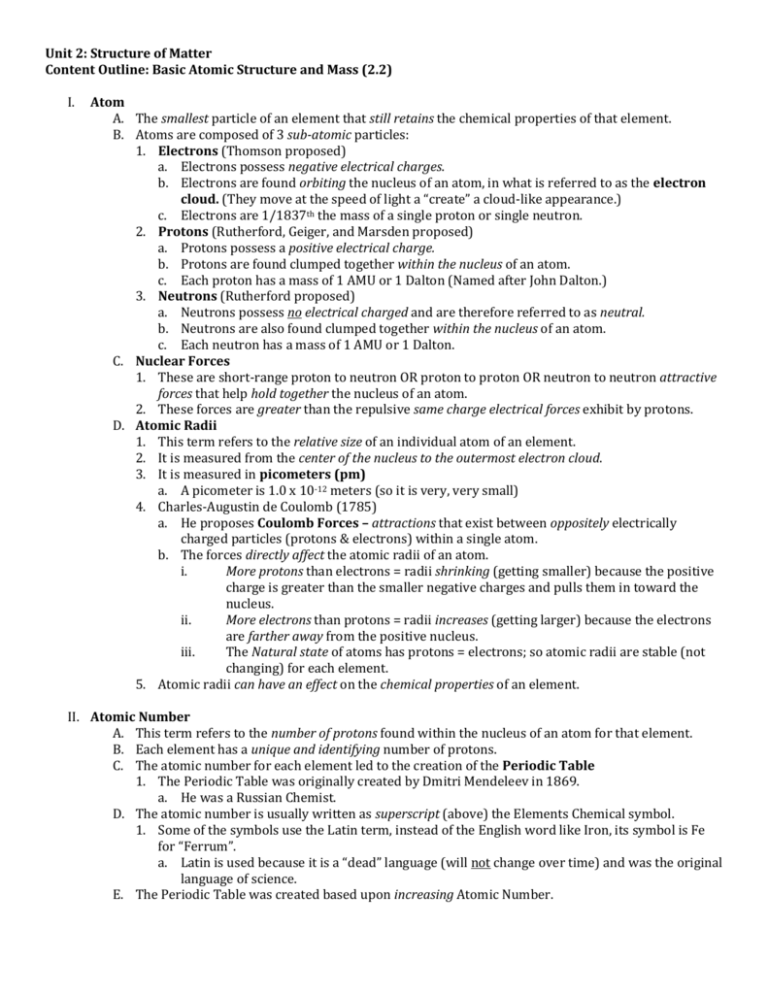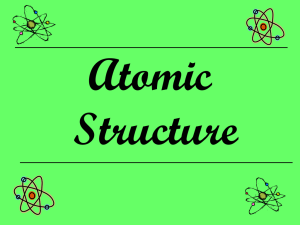Basic Atomic Structure (2.2)
advertisement

Unit 2: Structure of Matter Content Outline: Basic Atomic Structure and Mass (2.2) I. Atom A. The smallest particle of an element that still retains the chemical properties of that element. B. Atoms are composed of 3 sub-atomic particles: 1. Electrons (Thomson proposed) a. Electrons possess negative electrical charges. b. Electrons are found orbiting the nucleus of an atom, in what is referred to as the electron cloud. (They move at the speed of light a “create” a cloud-like appearance.) c. Electrons are 1/1837th the mass of a single proton or single neutron. 2. Protons (Rutherford, Geiger, and Marsden proposed) a. Protons possess a positive electrical charge. b. Protons are found clumped together within the nucleus of an atom. c. Each proton has a mass of 1 AMU or 1 Dalton (Named after John Dalton.) 3. Neutrons (Rutherford proposed) a. Neutrons possess no electrical charged and are therefore referred to as neutral. b. Neutrons are also found clumped together within the nucleus of an atom. c. Each neutron has a mass of 1 AMU or 1 Dalton. C. Nuclear Forces 1. These are short-range proton to neutron OR proton to proton OR neutron to neutron attractive forces that help hold together the nucleus of an atom. 2. These forces are greater than the repulsive same charge electrical forces exhibit by protons. D. Atomic Radii 1. This term refers to the relative size of an individual atom of an element. 2. It is measured from the center of the nucleus to the outermost electron cloud. 3. It is measured in picometers (pm) a. A picometer is 1.0 x 10-12 meters (so it is very, very small) 4. Charles-Augustin de Coulomb (1785) a. He proposes Coulomb Forces – attractions that exist between oppositely electrically charged particles (protons & electrons) within a single atom. b. The forces directly affect the atomic radii of an atom. i. More protons than electrons = radii shrinking (getting smaller) because the positive charge is greater than the smaller negative charges and pulls them in toward the nucleus. ii. More electrons than protons = radii increases (getting larger) because the electrons are farther away from the positive nucleus. iii. The Natural state of atoms has protons = electrons; so atomic radii are stable (not changing) for each element. 5. Atomic radii can have an effect on the chemical properties of an element. II. Atomic Number A. This term refers to the number of protons found within the nucleus of an atom for that element. B. Each element has a unique and identifying number of protons. C. The atomic number for each element led to the creation of the Periodic Table 1. The Periodic Table was originally created by Dmitri Mendeleev in 1869. a. He was a Russian Chemist. D. The atomic number is usually written as superscript (above) the Elements Chemical symbol. 1. Some of the symbols use the Latin term, instead of the English word like Iron, its symbol is Fe for “Ferrum”. a. Latin is used because it is a “dead” language (will not change over time) and was the original language of science. E. The Periodic Table was created based upon increasing Atomic Number. III. Atomic Mass Units (AMU) A. Also Known as (A.K.A.) Mass Number B. This term refers to the total weight of an atom of that element. C. It is found by adding the number of protons and neutrons together. 1. Each proton OR each neutron has a mass of 1 AMU or 1 Dalton. 2. Electrons mass is insignificant as they are so small (1/1837th that of protons/neutrons). D. The Atomic Mass is usually written as a subscript (below) the Element symbol. E. This was based on Carbon-12 as the standard element of measure. It has 12.0 AMU. IV. Isotopes A. This term refers to atoms of an element that have different masses (AMUs) because they have different numbers of neutrons within the atom; even though it is the same element because they have the same number of protons. (Remember, protons identify the element.) 1. The isotopes behave relatively the same as the natural atom in terms of chemical properties. 2. Some Isotopes are radioactive (the nucleus is “breaking apart”). B. To find the number of neutrons: AMU - # of protons (atomic number) = # neutrons C. How Isotopes are written chemically: 1. Hyphen notation – symbol- number, For example: Carbon -14 OR C-14. 2. Nuclear notation – AMU over Atomic Number symbol, for example 146 C. D. Nuclide 1. This term is used to refer to the nucleus only (no e- cloud) of an Isotope. V. Average Atomic Mass A. As some elements have several isotopes also present in nature, their masses must also be considered to find the average mass for an element (as seen on the Periodic Table). B. How to calculate the average atomic Mass of an element: Step 1: Multiply the AMU for a single isotope by the % found in nature. Cu 63 – AMU of 63 = 62.93 AMU; so 62.93 x 69.15% (nature) = 62.93 x .6915 = 43.52 AMU Cu 65 – AMU of 65 = 64.93AMU; so 64.93 x 30.85% (nature) = 64.93 x .3085 = 20.03 AMU Step 2: Add the all AMUs together. 43.52 + 20.03 = 63.55 AMU Step 3: Round to two places after the decimal for each isotope calculation in Step 1.









